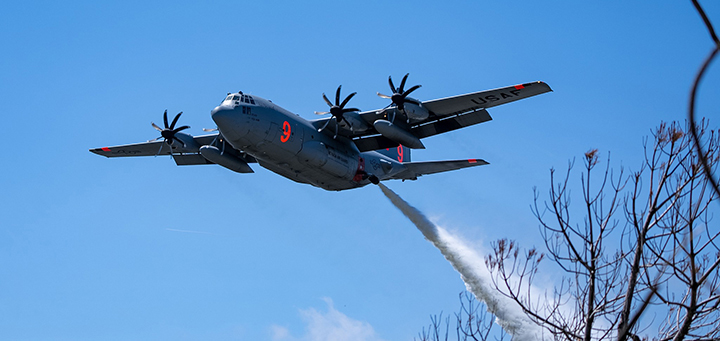Media Contacts:
NIFC: Stanton Florea 208-387-5437
stanton.florea@usda.gov
AFNORTH Public Affairs 850-774-1044
afnorth.pa@us.af.mil
Aerial wildland fire training taking place next week in Southern California
Boise, Idaho, May 4, 2023 – The USDA Forest Service, Bureau of Land Management and other federal wildland fire agencies will conduct annual training for Modular Airborne Firefighting Systems (MAFFS) personnel at Channel Islands Air National Guard Station in Port Hueneme, Calif., May 8-12.
The training will include personnel from the Air Force Reserve’s 302nd Airlift Wing, Peterson Air Force Base, Colo., and the host unit, the California Air National Guard’s 146th Airlift Wing. Four military C-130 Hercules aircraft will be utilized during the training as well as several lead planes.
The recertification training includes classroom sessions, flying and ground operations for Air Force aircrews, civilian lead plane pilots and support personnel from the Forest Service, Bureau of Land Management, and other federal and state agencies. The exercise is one of two this spring for the MAFFS program. The Wyoming Air National Guard’s 153rd Airlift Wing and the Nevada Air National Guard’s 152nd Airlift Wing went through the same training session at Channel Islands ANG Station in April.
“The MAFFS program is a tremendous example of how the USDA Forest Service and other wildland fire agencies work cooperatively with the military,” said Kim Christensen, deputy assistant director for operations for the Forest Service. “We conduct an annual training and certification exercise to ensure that MAFFS can be integrated into fire suppression operations in a safe, effective, and seamless manner. It helps ensure our mutual preparedness for the 2023 Fire Year.”
The eight C-130 Hercules aircraft that are part of the program are equipped with the Forest Service’s MAFFS, which can drop up to 3,000 gallons of fire retardant in less than 10 seconds across a quarter-mile line. The system slides into the back of the military aircraft, and retardant is released through a nozzle on the rear left side. MAFFS aircraft can be activated to provide a critical “surge” capability to help slow or stop the spread of wildland fires. MAFFS aircraft are only activated when all commercial airtankers that are part of the national airtanker fleet are fully committed or not readily available.
As part of the training in Southern California, practice water drops will be conducted on some remote portions of the Angeles National Forest. Residents and visitors in those areas may see low-flying C-130 aircraft and smaller lead planes throughout the week.
Note to news media: An opportunity to interview personnel and observe the training, including a practice water drop, will take place at Channel Islands ANG Station on Wednesday, May 10. If interested, please RSVP to Nicholas Carzis, 146th Airlift Wing Public Affairs, at 805-986-7420.
For more information on the MAFFS program, visit: www.fs.usda.gov/managing-land/fire/planes/maffs.
For background photos and videos of the program, visit: www.dvidshub.net/feature/MAFFSAEG.
###









